Tanzania is an extremely various nation and gives a rewarding safari expertise for avid birdwatchers. Residence to over 1,100 fowl species, this East African safari hotspot can also be one of many prime birding locations in Africa. On this article we check out 10 birds you’re more likely to spot on a fowl safari in Tanzania.
Tanzania Chicken Safari Hotspots
Aside from the well-known nationwide parks, the nation has a number of areas which might be teeming with unimaginable fowl species.
- Usambara Mountains: These mountains are considered a biodiversity hotspot, residence to endemic fowl species and plush, historical forests.
- Kilimanjaro Area: The varied habitats round Mount Kilimanjaro, from alpine deserts to rainforests, present birders with alternatives to identify high-altitude species and all kinds of avian life.
- Mahale Mountains: Set alongside the shores of Lake Tanganyika, these mountains provide a wealthy mosaic of habitats, from montane forests to grasslands, attracting a splendid array of fowl species, together with some uncommon and endemic, making it an distinctive birding vacation spot.
Birdwatching excursions and guided journeys can be found for seasoned fanatics and learners alike, with guides who’re eager to share their information of the completely different species and habitats.
Past endemic and near-endemic species, Tanzania can also be a part of the East African flyway, which brings tens of millions of migrant species via the nation yearly
READ: Tanzania Via the Lens: 5 Should-Go to Safari Locations
Ten birds to identify whereas on safari in Tanzania
From the African Fish Eagle to the we’ll take a better have a look at 10 birds you’re more likely to spot on safari in Tanzania.
-
African Fish Eagle (Haliaeetus vocifer)
Immediately recognizable by its placing look, the African Fish Eagle has a particular white head and breast, with a contrasting darkish brown physique and wings. It has a outstanding, yellow, hooked beak, and vivid yellow eyes. This eagle is often discovered close to freshwater habitats reminiscent of lakes, rivers, marshes, and coastal lagoons, the place there’s loads of fish.
African Fish Eagles are expert hunters with eager eyesight, permitting them to identify prey from a substantial distance. Look out for his or her dramatic aerial shows as they swoop all the way down to seize their prey.
These eagles type monogamous pairs that mate for all times. They construct massive stick nests in tall timber close to our bodies of water and can typically reuse the identical nest 12 months after 12 months. Females lay one to a few eggs and each mother and father take turns incubating the eggs and caring for his or her younger.
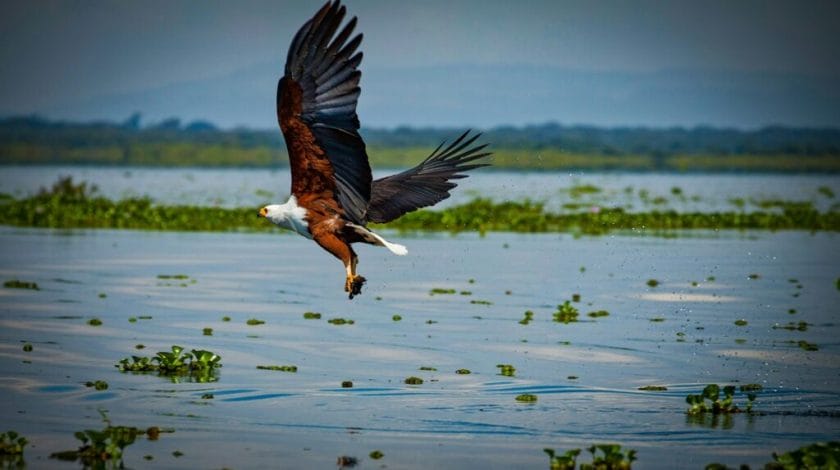

-
Lilac-breasted Curler (Coracias caudatus)
This fowl is famend for its vibrant plumage, which contains a sensible mixture of colours. It has a lilac-colored throat and breast, a turquoise stomach, and a cobalt-blue again. You’ll discover the Lilac-breasted Curler in a wide range of open habitats, together with savannas, woodlands, scrublands, and grasslands. They typically perch on uncovered branches and are identified for his or her acrobatic flight shows, together with aerial pursuits and swoops. These agile maneuvers assist them catch bugs in flight.
Whereas Lilac-breasted Rollers are solitary or present in pairs in the course of the breeding season, you would possibly see them gathering of their numbers at appropriate feeding areas. They construct cup-shaped nests in tree cavities or holes, the place the feminine lays a clutch of two to 4 eggs. Mother and father share incubating and feeding duties as soon as the eggs hatch.


-
Excellent Starling (Lamprotornis superbus)
Recognized for its vivid and iridescent plumage, the Excellent Starling has a shiny again, head, and tail, with vivid blue wings, and a particular orange-brown chest and stomach. Its eyes are pale yellow and its invoice is black. Whereas men and women exhibit comparable coloration, males usually have barely brighter plumage.
Excellent Starlings are generally present in a spread of habitats, together with open woodlands, savannas, scrublands, grasslands, and agricultural areas. They’re an adaptable species and thrive in each pure and human-altered landscapes. Usually noticed in small to medium-sized flocks, they’re a sociable species that engages in aerial shows, particularly in the course of the breeding season.
From October to December, Excellent Starlings type monogamous pairs, constructing cup-shaped nests in timber, shrubs, or man-made buildings. The feminine lays a clutch of two to 5 eggs and each mother and father take turns incubating and caring for the chicks as soon as they’ve hatched. Chicks fledge after about three weeks.
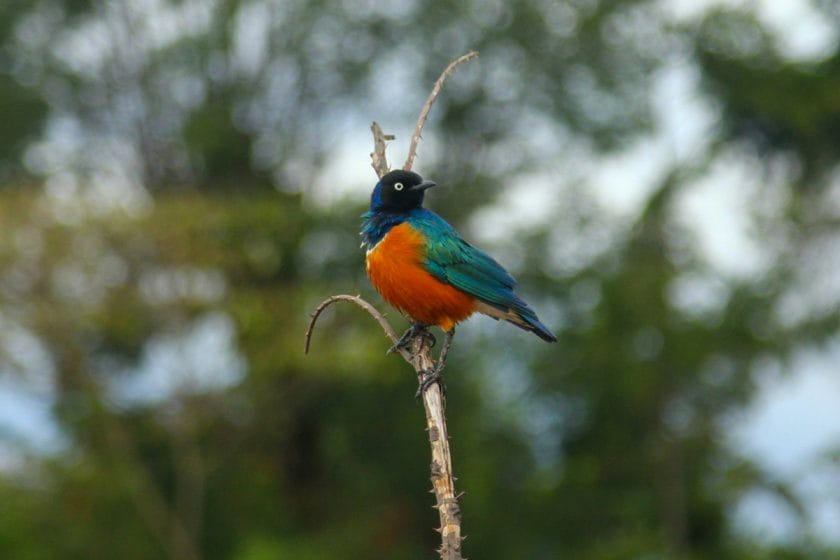

-
Yellow-billed Hornbill (Tockus flavirostris)
This fowl is characterised by its placing look, with primarily black and white plumage, a black physique, wings, and tail, and white underparts and first flight feathers. Its most notable function is its massive yellow invoice, which is lengthy, down-curved, and barely flattened. Its eyes are pale yellow, whereas its legs and ft are grayish-black.
The Yellow-billed Hornbill might be present in an array of habitats, together with savannas, woodlands, scrublands, and thornveld, and might usually be noticed perched on tree branches or foraging on the bottom. This species of hornbill is often solitary or present in small household teams consisting of a breeding pair and their offspring.
Yellow-billed Hornbills are cavity-nesters, utilizing pure tree hollows or deserted nest websites. They breed in the course of the dry season from June to November. Throughout this time, the feminine seals herself contained in the nest cavity utilizing mud, leaving solely a slender slit via which the male passes meals. In a season, the feminine will lay a clutch of two to 4 eggs. After a number of weeks the feminine and chicks will probably be free of the nest.
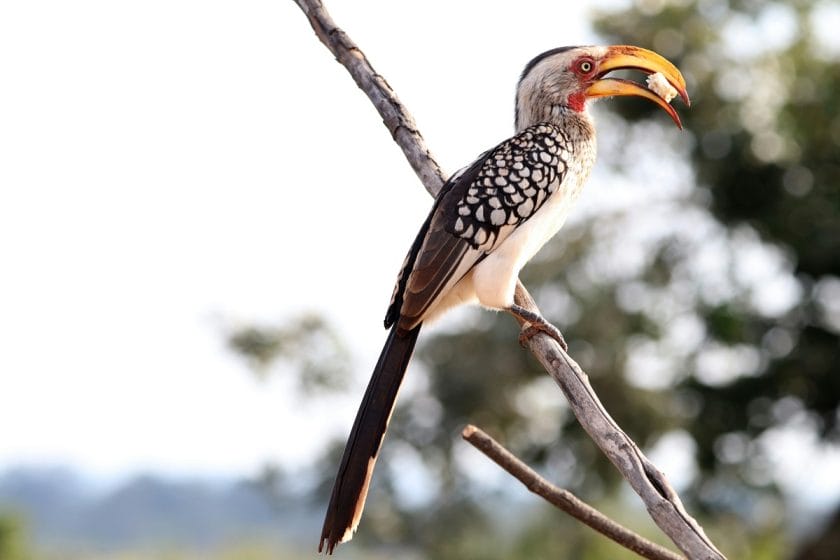
Yellow invoice hornbill perched in a tree. Picture: Jonathan Gensicke, Unsplash.
-
Gray Topped Crane (Balearica regulorum)
The Gray Topped Crane is an iconic, placing species with a tall, slender physique, lengthy legs and neck. Its plumage is especially grey, with a white higher neck and chest, and a black-and-white striped decrease neck. Its defining function is its crown of golden feathers. Throughout courtship shows, the crown feathers are raised right into a regal crest. Its invoice is brief and grayish-black, and its eyes are surrounded by a patch of naked pink pores and skin.
This species of crane might be present in a wide range of wetland and grassland habitats, together with marshes, savannas, moist meadows, and cultivated areas. It’s typically discovered close to rivers, lakes, and swamps, the place there’s a dependable supply of meals and protected roosting locations. Whereas these cranes are usually present in pairs or small household teams, they’ll generally be noticed in bigger flocks at appropriate feeding and roosting websites.
Gray Topped Cranes are expert dancers and have interaction in elaborate courtship shows, together with leaping, bowing, and calling, to draw mates and strengthen pair bonds. They’re monogamous and type long-term pair bonds, constructing massive, shallow nests on the bottom, normally hid by vegetation for defense. The feminine lays a clutch of two to 4 eggs and each mother and father are concerned with incubating and feeding the chicks.
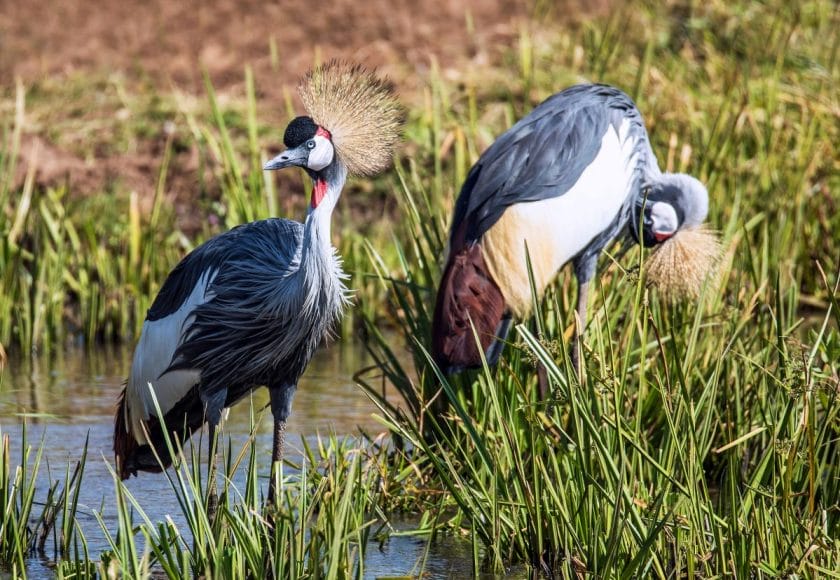

-
Marabou Stork (Leptoptilos crumenifer)
This huge and distinctive fowl species is immediately recognizable by its huge dimension and naked head and neck. Its plumage is predominantly white, with black combat feathers on its wings and tail. Its neck is lengthy and scaly, with a pinkish or reddish hue, and lacks feathers aside from a sparse overlaying of down. The top is massive and wrinkled, with a heavy invoice that’s lengthy, broad, and barely curved.
The Marabou Stork favors a variety of habitats, together with wetlands, rivers, lakes, marshes, grasslands, and even city areas. These storks are normally solitary or present in small teams, however can congregate in bigger teams if the feeding and roosting websites assist it. They spend a lot of their time foraging for meals on the bottom or in shallow water the place they hunt for reside prey reminiscent of fish, amphibians, reptiles, and bugs.
This species of stork is a colonial breeder and should nest in massive colonies, generally alongside different species of waterbirds. They construct massive stick nests in timber, cliffs, or man-made buildings, the place the feminine lays a clutch of two to a few eggs. Each mother and father take turns incubating the chicks and caring for them as soon as they’ve hatched.


-
Helmeted Guineafowl (Numida meleagris)
The Helmeted Guineafowl has a plump physique lined in darkish grey feathers with white spots, giving it a speckled look. Its head is adorned with a bony casque or helmet-like construction, which is raised throughout shows or when the fowl is alarmed. The face is usually naked, with blue and pink pores and skin patches across the eyes and on the throat. The invoice is brief and stout and the legs are nicely tailored for operating.
You’ll discover this fowl in a wide range of habitats, together with savannas, grasslands, scrublands, and agricultural areas. They like open areas with scattered timber or shrubs the place they’ll forage and search shelter from predators. They’re usually present in small to medium-sized flocks, and so they’re extremely social creatures identified for his or her loud calls and vocalizations.
Helmeted Guineafowl are monogamous and type pairs in the course of the breeding season from February to July. Throughout this time they’ll construct shallow floor nests hid inside vegetation. The feminine will lay a clutch of six to 12 eggs, and each mother and father will play their half incubating and caring for the chicks after hatching.
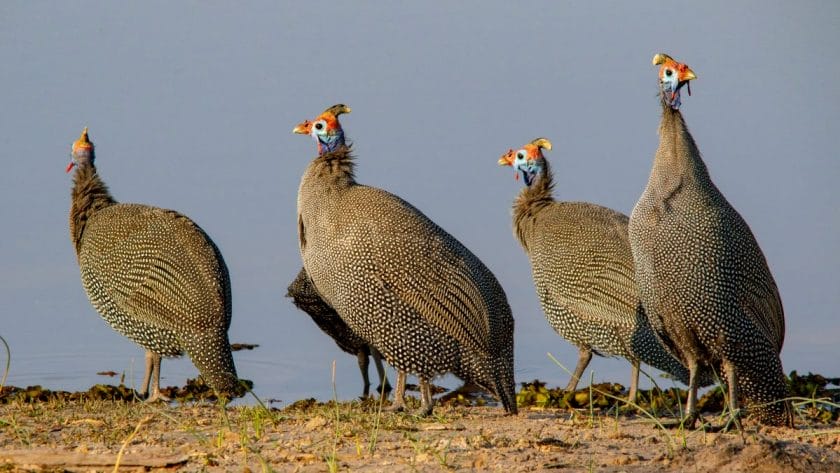

-
African Jacana (Actophilornis africanus)
The African Jacana’s distinctive look and habits make it simple to acknowledge. It has a comparatively small physique with lengthy legs and toes, which permits it to stroll on floating vegetation with out sinking. Plumage is especially brown and buff, with a black head, neck, and higher breast. Its wings are largely black with white patches, and its underparts are white with black barring. Through the breeding season, grownup males develop placing chestnut-colored wings and an enlarged frontal defend on the brow, which they use in territorial shows.
The African Jacana inhabits a wide range of wetland habitats, together with marshes, swamps, shallow lakes, rivers, streams, and flooded grasslands. It favors areas with considerable floating vegetation, reminiscent of water lilies, reeds, and grasses, the place there may be loads of meals and appropriate nesting area. They’re normally solitary or present in small household teams however have been identified to type bigger teams in habitats with enough feeding and nesting websites.
African Jacanas are polyandrous, with females mating with a number of males inside their territory in the course of the breeding season. They construct shallow cup-shaped nests on floating vegetation, the place the feminine lays a clutch of three to 4 eggs. The male takes the accountability for incubating the eggs and caring for the chicks as soon as they’ve hatched. Whereas the chicks are capable of swim and feed shortly after hatching, they continue to be depending on their mother and father for a number of weeks.
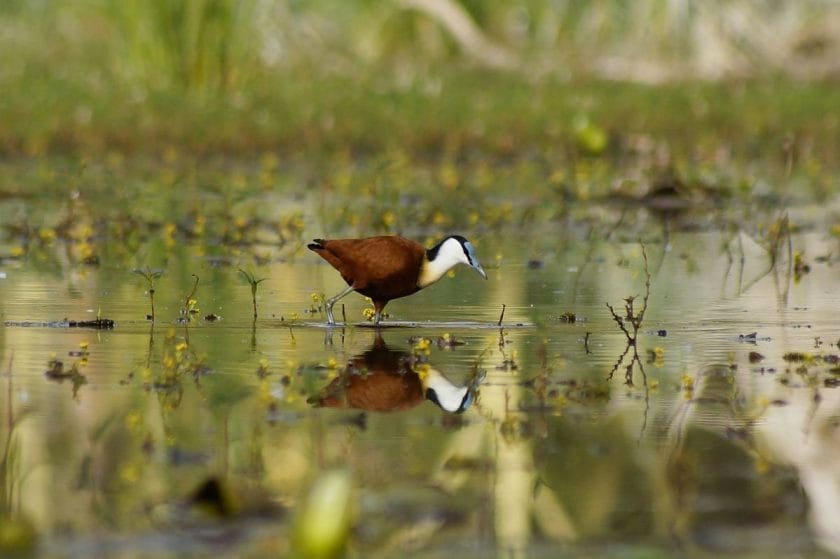

-
White-backed Vulture (Gyps africanus)
This huge and highly effective fowl of prey is characterised by its imposing dimension, broad wings, and distinctive plumage. It has a predominantly darkish brown physique, with a white or creamy-white again and rump. Its head and neck are feathered and sometimes seem pale, contrasting with the darkish plumage of its physique. The hooked invoice is robust and well-adapted to ripping via powerful flesh, whereas the sturdy legs and feed enable it to understand and carry prey.
White-backed Vultures choose a wide range of open habitats, together with savannas, grasslands, woodlands, and scrublands. They’re typically present in areas with considerable massive mammal populations, reminiscent of nationwide parks, recreation reserves, and locations with in depth livestock farming. These vultures are extremely social birds typically seen in massive teams, particularly round carcasses or feeding websites. Primarily scavengers, they’re sturdy fliers and might soar effortlessly for lengthy durations and over nice distances seeking carrion.
This species of vulture is monogamous, and kinds long-term pair bonds. It usually nests in colonies, with a number of pairs breeding in shut proximity to one another. The nest is a big platform constructed of sticks and branches in-built tall timber or on cliffs. The feminine lays a single egg, which each mother and father take turns incubating for round fifty to sixty days. As soon as hatched, the chick is fed regurgitated meals by each mother and father and fledges after about three to 4 months.
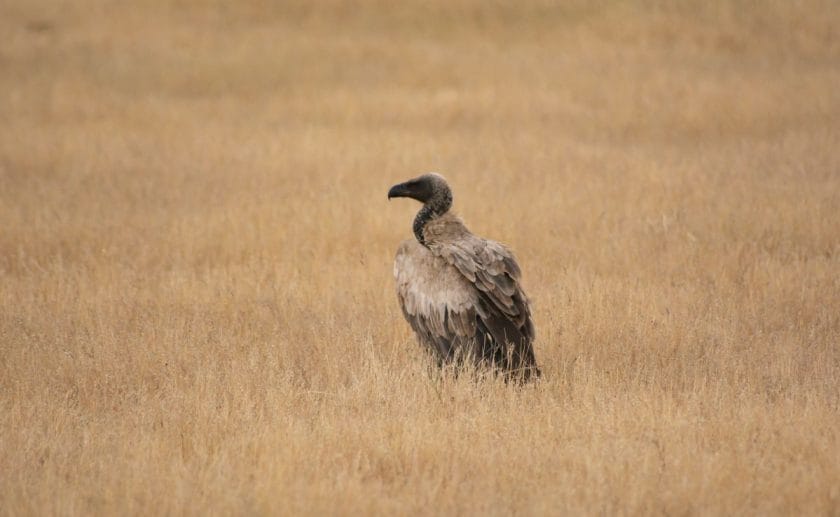

-
Southern Floor Hornbill (Bucorvus leadbeateri)
The Southern Floor Hornbill is without doubt one of the largest hornbill species, with adults measuring as much as 51 inches and weighing as much as 14 kilos. It has primarily black plumage, with white major feathers on the wings, a pink throat patch, and a naked patch of blue or violet pores and skin across the eyes and throat. Its invoice is lengthy, sturdy, and barely down-curved, with a bony casque on prime. This protuberance is often bigger in males.
Southern Floor Hornbills can normally be present in open habitats, reminiscent of savannas, grasslands, woodlands, and scrublands. They like areas with scattered timber or thorny bushes, which give protected roosting and nesting websites.
Primarily terrestrial, they spend a lot of their time strolling and foraging on the bottom. They’re extremely social birds and usually journey in small household teams consisting of a breeding pair and their offspring. They impart with loud, booming calls, which serve to keep up contact inside the group and set up territory boundaries.
Southern Floor Hornbills are monogamous and type long-term pair bonds. They nest in pure cavities, reminiscent of hole timber or rock crevices, the place the feminine lays a clutch of 1 to a few eggs. The mother and father take turns incubating the eggs and caring for the chicks as soon as they hatch. Chicks fledge after about three to 4 months, however are depending on their mother and father for a number of months after leaving the nest.
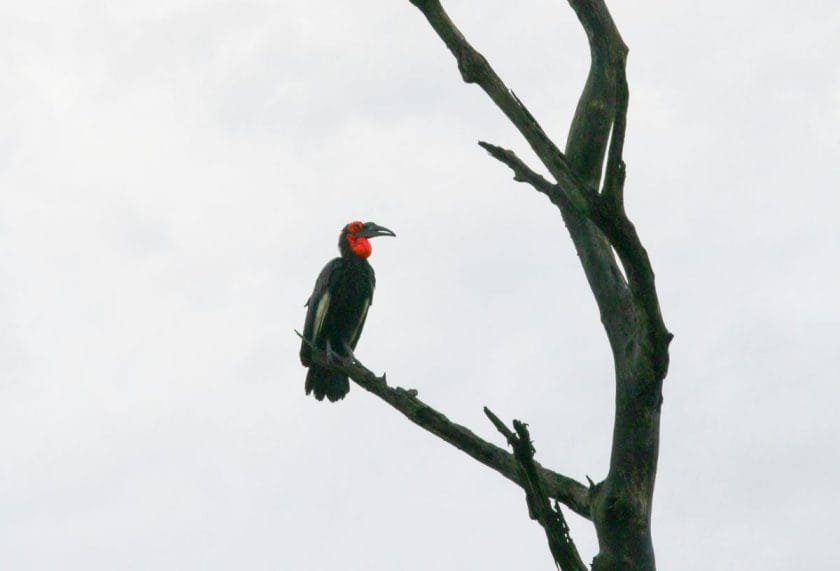
A Southern Floor Hornbill noticed in a tree prime. Picture: Glen Carrie, Unsplash.
Tanzania’s thriving birdlife and gorgeous pure magnificence make it a haven for birders seeking to tick all kinds of species off their record. Converse to a Uncover Africa safari professional right this moment about planning a luxurious, tailored fowl watching safari in Tanzania.

